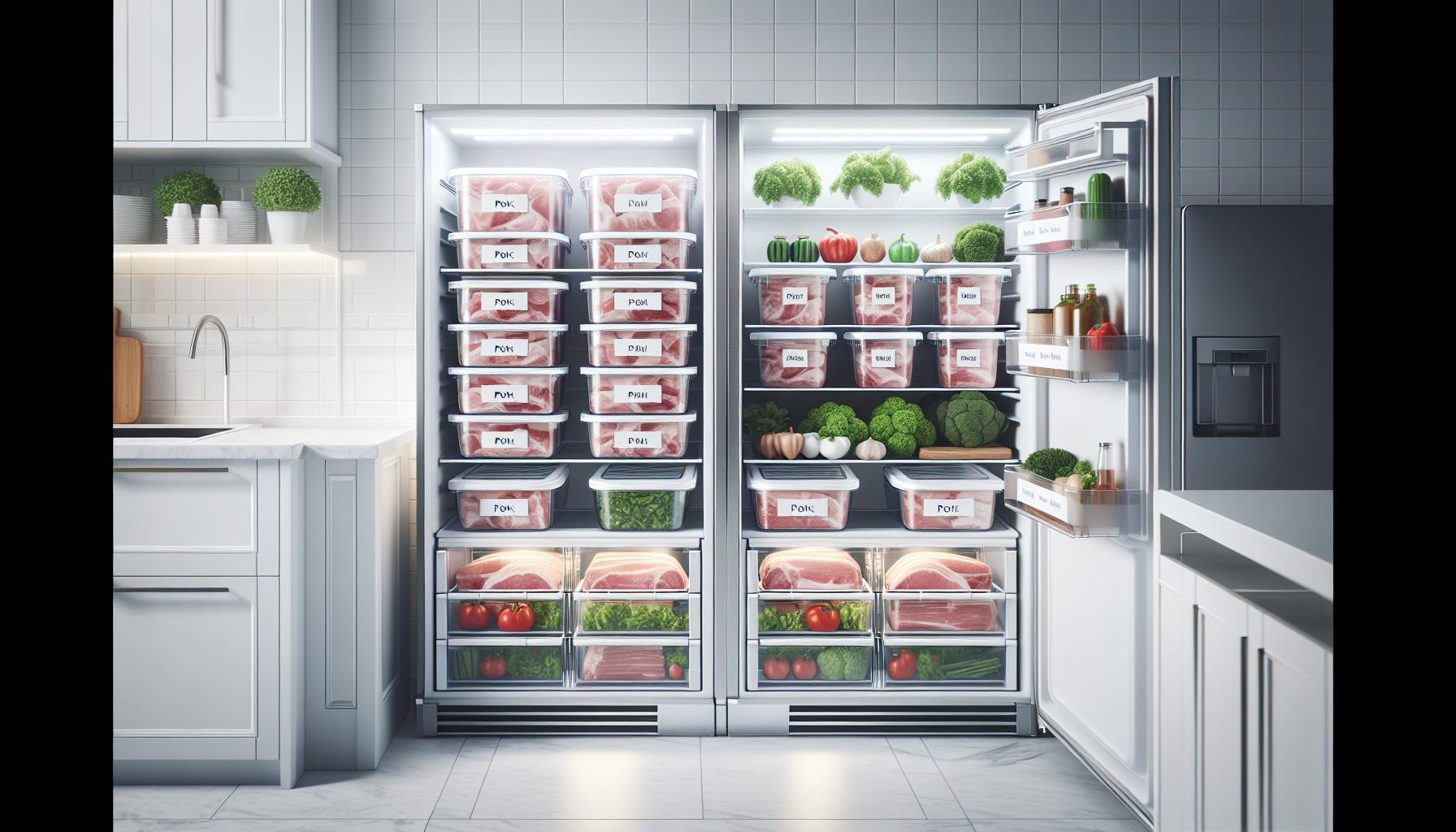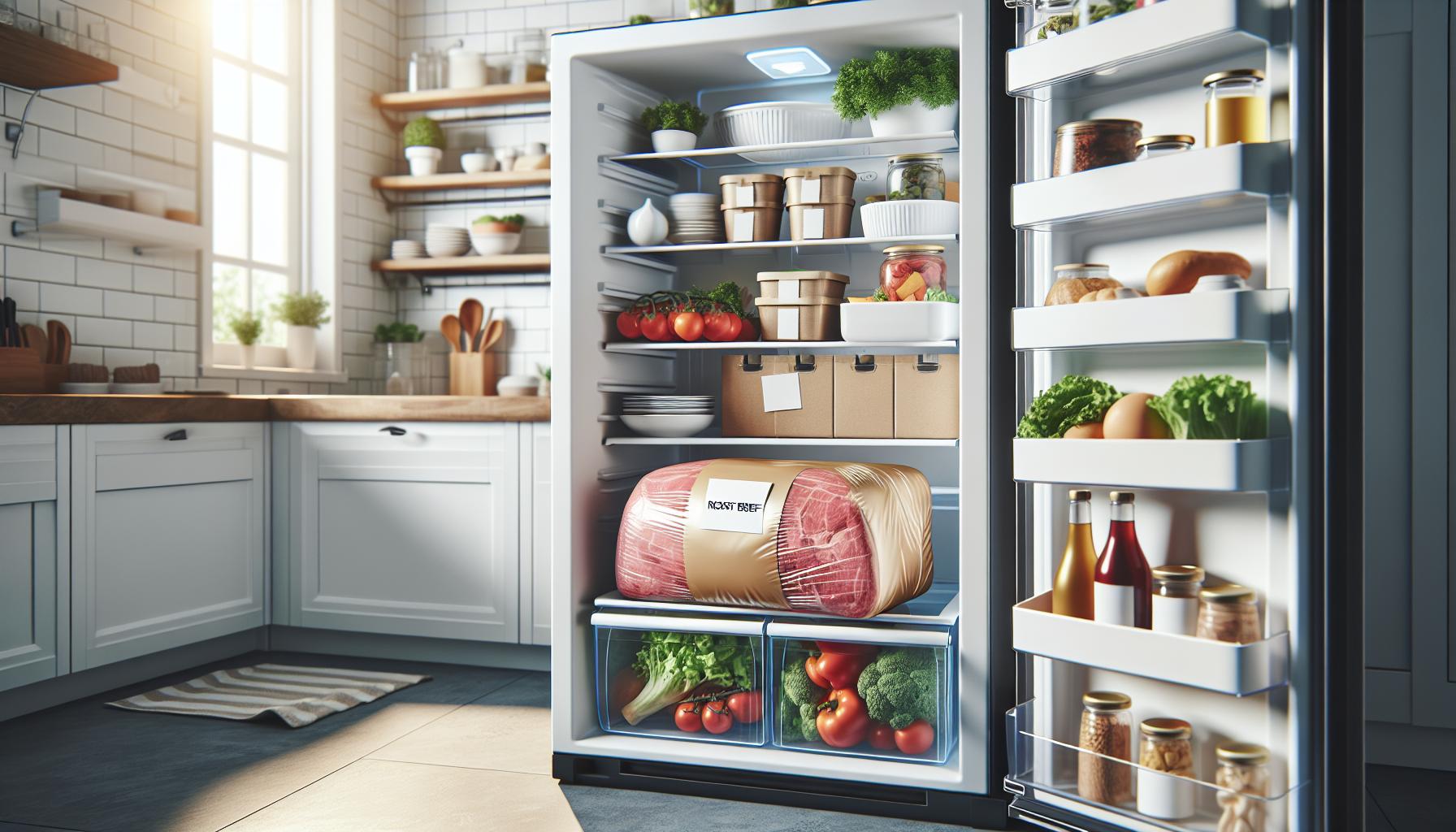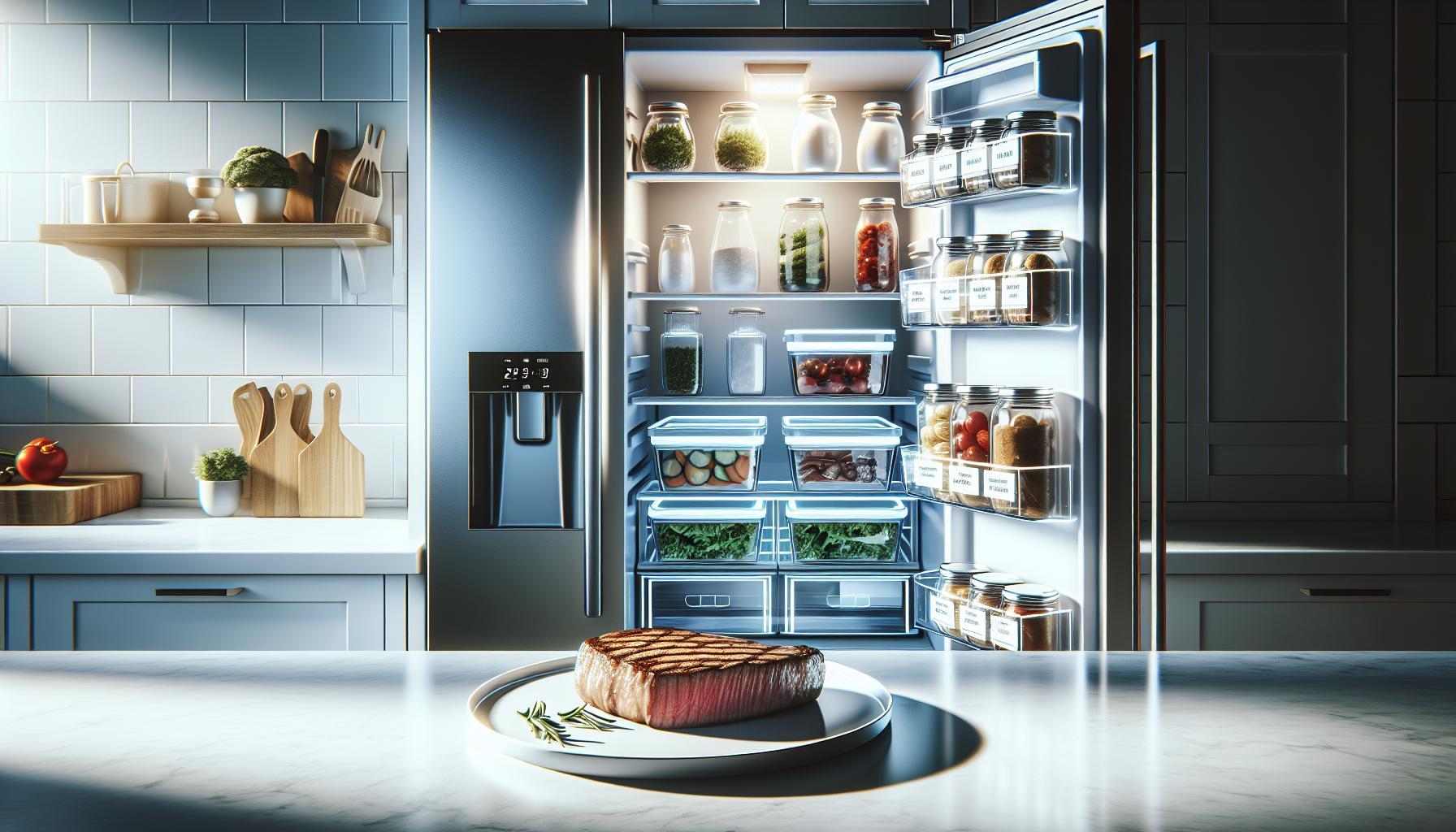When it comes to food safety, knowing how long raw pork can last in your fridge is essential for preventing foodborne illnesses and ensuring delicious meals. Raw pork typically keeps its best quality for about three to five days when stored correctly in the refrigerator. However, many factors, including temperature and packaging, can affect its longevity.
Understanding the proper storage techniques not only maximizes freshness but also provides peace of mind. Whether you’re planning a family feast or simply trying to reduce waste, being informed about the safe storage of raw pork is key. With clear guidelines and practical tips, you can confidently navigate your refrigerator, ensuring your meals are both safe and satisfying. Continue reading to discover everything you need to know about storing raw pork safely and effectively.
How Long Can Raw Pork Stay Fresh in the Fridge?

Raw pork can be a delicious and versatile ingredient in your kitchen, but proper storage is essential to ensure its freshness and safety. In the refrigerator, raw pork can stay fresh for up to 3 to 5 days. This guideline applies to various cuts, whether it be chops, roasts, or ground pork. It is crucial to place the pork in the coldest part of your fridge immediately after purchase to maximize its shelf life.
To help keep track of how long your pork has been stored, consider labeling it with the purchase date. This practice will remind you when it needs to be used or discarded, preventing the risk of consuming spoiled meat. Additionally, be mindful of the temperature in your fridge; it should be maintained at or below 40°F (4°C) for optimal freshness. Always check your pork for any off-putting odors or discoloration before cooking, as these can be indicators of spoilage.
For longer storage, consider freezing the pork, which can extend its shelf life to 4 to 6 months without significant loss of quality. When you decide to store it in the freezer, ensure it is well-wrapped to prevent freezer burn, which can impact both flavor and texture. By following these storage guidelines, you can enjoy the delicious taste of pork while ensuring safety and quality in every meal.
Understanding Pork Storage Timelines
Raw pork, when handled and stored correctly, can safely provide meals for days. Understanding the specific timelines for how long different pork cuts can be stored in your fridge is crucial for both safety and quality. Generally, raw pork can be refrigerated for 3 to 5 days. This timeframe applies to various types of cuts, such as chops, roasts, and ground pork. Storing pork at optimum conditions ensures you get the most out of your purchase while minimizing food waste.
Here are some key considerations for :
- Freshness Indicators: When you buy pork, look for freshness indicators such as color and smell. Fresh pork should have a pinkish hue and a clean scent. Always trust your senses when determining freshness.
- Packaging Matters: The original packaging can affect freshness. If the packaging is compromised, consider rewrapping the pork in moisture-resistant wrap to minimize exposure to air, which can lead to spoilage.
- Temperature Control: To maintain quality, ensure that your refrigerator is set to 40°F (4°C) or lower. This prevents the rapid growth of harmful bacteria.
- Timing: Mark your calendar or label packages with purchase dates. This simple practice can help you stay on top of usage timelines.
For longer-term storage, freezing is an excellent option. When stored properly in the freezer, pork can last 4 to 6 months without a significant loss in quality. Ensuring that pork is tightly wrapped before freezing is imperative to prevent freezer burn. By following these guidelines, you can feel confident about safely enjoying your pork dishes without the worry of spoilage.
Signs of Spoiled Raw Pork to Watch For

Recognizing the signs that raw pork has spoiled is essential for ensuring food safety. As pork is prone to bacterial growth if not stored properly, it’s crucial to be vigilant about its condition. Spoiled raw pork often displays a combination of visual, olfactory, and textural changes that can indicate its unsuitability for consumption.
One of the first indicators of spoilage is color. Fresh pork is typically light pink, while spoiled pork may exhibit a duller or greyish hue. Additionally, if you observe any discoloration, such as green or brown spots, it’s a strong sign that the meat is no longer safe to eat. Equally important is the smell; fresh pork should have a mild scent, while spoiled pork may carry a sour or rancid odor. If the meat has a pungent or off-putting smell, it’s best to discard it immediately.
Texture plays a significant role as well. Fresh pork has a firm and slightly moist texture. However, if the texture feels slimy or sticky to the touch, this is a clear indication of spoilage. Such changes in texture can signal the growth of bacteria and other pathogens, making the meat unsafe for consumption.
To summarize, always check for changes in color, smell, and texture when handling raw pork. Your senses are your best allies in food safety. If anything seems off, it’s essential to err on the side of caution and dispose of the meat to prevent potential foodborne illness.
Best Practices for Storing Raw Pork

To ensure the freshness and safety of raw pork, implementing best practices for storage is crucial. Raw pork can be a breeding ground for bacteria if not handled appropriately, making proper storage fundamental for food safety. It should be stored in the refrigerator at a temperature that keeps it safe for consumption and maintains its quality.
A good guideline is to keep raw pork in the coldest part of your refrigerator, ideally at temperatures below 40°F (4°C). If you don’t plan to use the pork within a few days, it’s best to freeze it. Raw pork can generally last in the fridge for 3 to 5 days before needing to be cooked or frozen. For longer storage, consider freezing the pork, where it can last for 4 to 6 months depending on the cut-although for the best quality, using it sooner is always ideal.
Storing raw pork properly also involves using airtight packaging. Ensure that pork is tightly wrapped in plastic wrap or aluminum foil or store it in a sealable bag to minimize exposure to air. This helps prevent freezer burn and extends the meat’s freshness. Keeping it in its original packaging is okay if it’s unopened. Just be sure to double wrap it if you’re freezing it, as this provides an extra layer against air exposure.
When it comes to handling, always use separate utensils and cutting boards for raw pork to prevent cross-contamination. Keeping raw meat contained helps maintain a clean environment and reduces the risk of bacteria spreading to other foods. Remember also to label the packages with dates to track how long it has been stored. This simple step can prevent confusion and aid in maintaining food safety.
In summary, proper storage of raw pork involves maintaining cold temperatures, using airtight wrapping, preventing cross-contamination, and labeling packages with dates. Adhering to these best practices not only extends the shelf life of the meat but also enhances safety in meal preparation.
Safe Temperature Guidelines for Pork Storage

To keep raw pork safe for consumption, adhering to temperature guidelines is critical. The USDA advises that raw pork should be stored in the refrigerator at or below 40°F (4°C) to minimize the growth of harmful bacteria. Keeping pork in the coldest part of your fridge, typically near the back, can help maintain this temperature. When properly stored under these conditions, raw pork will remain fresh for 3 to 5 days.
For longer-term storage, freezing is an excellent option. When pork is frozen, it can last for 4 to 6 months, depending on the cut. While freezing significantly slows bacterial growth, it’s important to note that the quality of the meat may degrade over time, so it’s best to consume it sooner rather than later for optimal taste and texture.
Maintaining a consistent temperature is paramount. Fluctuations can lead to condensation and cause bacteria to thrive. Consider investing in an appliance thermometer to monitor your refrigerator’s temperature regularly. Not only does this help in ensuring food safety, but it also promotes better energy efficiency.
In addition to monitoring temperatures, consider the packaging of your pork. Any outer wrapping should be airtight to prevent freezer burn and moisture loss, which can negatively affect both safety and quality. If the meat is in its original packaging, you might want to double wrap it before freezing for an extra layer of protection.
For practical strategies, label your pork with the purchase date or the date it was frozen. This simple practice allows for easy tracking and helps ensure that you use older cuts before they reach the recommended timeline. Staying informed about safe temperature guidelines not only protects your health but also enhances your culinary experience.
The Importance of Sealing and Wrapping Pork Properly
Properly sealing and wrapping raw pork is essential for maintaining its freshness, flavor, and safety. When exposed to air, pork can suffer from freezer burn, which deteriorates the quality of the meat, leading to an unappetizing texture and taste. Hence, effective sealing not only preserves the integrity of the cuts but also extends their shelf life significantly.
To ensure optimal storage, start with the original packaging from the butcher or store. If it’s tightly sealed and intended for refrigeration, it can be sufficient for short-term storage (3 to 5 days in the fridge). However, for longer-term storage-especially in the freezer (4 to 6 months)-additional measures should be taken. Use additional airtight packaging, such as heavy-duty aluminum foil or plastic freezer bags, to provide a barrier against air and moisture. Remove as much air as possible from the bags, as oxygen promotes spoilage.
Best Practices for Sealing Pork
- Double-Wrapping: If using plastic wrap, follow it up with a layer of aluminum foil for extra protection. This technique helps prevent air leakage.
- Vacuum Sealing: This method removes air from the packaging entirely, significantly reducing the risk of freezer burn and extending the meat’s lifespan.
- Labeling: Always label your sealed pork with the purchase or freezing date. This will help you keep track of how long the meat has been stored and avoid using it past its best quality.
Remember, the goal is to create an airtight environment that minimizes exposure to air and moisture. Proper sealing not only safeguards the quality of pork but also crucially ensures food safety. By following these best practices, you can enjoy fresh, flavorful pork in your meals while minimizing the risk of foodborne illnesses associated with spoilage.
How to Thaw Frozen Pork Safely
Thawing frozen pork safely is a crucial step in food preparation that ensures both flavor and safety. When meat is frozen, ice crystals form within its cells, and if thawed improperly, can lead to uneven cooking and foodborne illnesses. The safest ways to thaw pork involve controlled temperature methods that keep the meat out of the danger zone (40°F to 140°F) where bacteria thrive.
To safely thaw frozen pork, consider the following methods:
- Refrigerator Thawing: This is the safest method. Simply transfer the pork from the freezer to the refrigerator and allow it to thaw slowly. Depending on the size of the cut, this may take anywhere from several hours to a full day. Once thawed, pork can remain in the fridge for an additional 3 to 5 days before cooking.
- Cold Water Thawing: For a quicker option, submerge the pork, still sealed in its packaging, in cold water. Change the water every 30 minutes to ensure that it stays cold. This method can take about 1 to 3 hours, depending on the thickness of the cut. Pork thawed this way should be cooked immediately.
- Microwave Thawing: If you’re short on time, you can use the microwave to thaw pork. Follow the microwave manufacturer’s instructions. Be aware that some areas of the meat may begin to cook during this process, so it is essential to cook the meat right after thawing to prevent any safety issues.
Regardless of the thawing method chosen, avoid leaving pork out at room temperature to thaw, as this creates a breeding ground for harmful bacteria. For those who find themselves frequently in need of thawed meat, consider planning meals and transferring cuts from the freezer to the refrigerator a day in advance. This ensures you always have fresh pork ready for your culinary creations while maintaining food safety standards. Adopting proper thawing practices helps ensure that the pork you prepare is both delicious and safe for consumption.
Tips for Meal Prep and Raw Pork Storage
Keeping your raw pork fresh and safe for meal preparation requires attention to storage practices at home. A crucial point for anyone who frequently incorporates pork into their meals is understanding how long raw pork can last in the fridge. Generally, raw pork can be kept in the refrigerator for up to three to five days. To maximize its freshness, it’s advisable to store it in the coldest part of your fridge, typically not in the door, as this area is subject to fluctuating temperatures.
When it comes to meal prep, planning ahead can greatly enhance safety and efficiency. If you purchase pork in bulk, consider dividing it into meal-sized portions before storing. Use airtight containers or heavy-duty freezer bags to prevent exposure to air and moisture, which can lead to spoilage. Remember to label each package with the date of storage; this not only helps you track freshness but also simplifies meal planning for the upcoming days.
It’s also essential to utilize a clean, sanitized cutting board and utensils when handling raw pork to avoid cross-contamination. Keep raw pork separate from ready-to-eat foods, such as fruits and vegetables, in your fridge. Additionally, always ensure you wash your hands with soap and water after handling raw meat to maintain a safe cooking environment.
Knowing when to discard raw pork is just as important as knowing how to store it. If you notice an off smell, slimy texture, or discoloration, these are clear signs that the pork has gone bad. Trust your senses; if something doesn’t look or smell right, err on the side of caution and dispose of it. Following these tips can help you feel confident in your meal prep, ensuring your dishes are both delicious and safe to enjoy.
Using a Food Thermometer for Safety
Using a food thermometer is one of the most reliable ways to ensure that pork reaches a safe internal temperature, which is crucial for eliminating harmful bacteria. The U.S. Department of Agriculture (USDA) recommends cooking pork to an internal temperature of at least 145°F (63°C), followed by a three-minute rest time. This cooking process not only enhances flavor and texture but also ensures safety for you and your loved ones.
To effectively use a food thermometer, insert it into the thickest part of the pork, avoiding any bones, as these can give an inaccurate reading. For maximum accuracy, consider the following steps:
- Choose the Right Thermometer: There are various types of thermometers-instant-read, digital, and probe. Instant-read thermometers are excellent for check-ups, whereas probe types are ideal for longer cooking processes.
- Calibrate Your Thermometer: Periodically check your thermometer’s accuracy by placing it in ice water (should read 32°F or 0°C) or boiling water (should read 212°F or 100°C). If it doesn’t match, adjust accordingly.
- Insert Properly: Ensure you insert the thermometer deep enough to capture the true temperature of the meat, usually about two inches into the thickest portion.
- Read and Rest: Once the meat has reached 145°F, remove it from the heat and let it rest for at least three minutes. This allows juices to redistribute and enhances taste.
Using a thermometer provides peace of mind, especially when preparing raw pork that may have been stored for several days. While refrigeration can slow bacteria growth, it does not stop it completely. Therefore, verifying that pork has been cooked to a safe temperature decreases the chance of foodborne illnesses. In case you are working with leftovers or reheating previously cooked pork, remember that it should reach an internal temperature of 165°F (74°C) to be considered safe to consume.
Investing in a good food thermometer not only helps in cooking meats safely but also improves your overall culinary skills, ensuring that every meal is both enjoyable and safe.
Storage Containers That Keep Pork Fresh Longer
To maximize freshness and maintain the quality of raw pork, the choice of storage containers plays a crucial role. Using appropriate containers not only extends the shelf life of your meat but also prevents cross-contamination and maintains a hygienic environment. Here’s how to approach storage effectively.
One of the best options for storing raw pork is airtight containers. These containers, made from glass or heavy-duty plastic, help minimize exposure to air, which can lead to oxidation and spoilage. Be sure to select containers that are specifically labeled for food storage to ensure safety and durability. For an added layer of protection, consider using vacuum-sealed bags, which remove air and significantly reduce the risk of freezer burn if you plan to store pork in the freezer for an extended period.
When utilizing plastic wrap or aluminum foil, ensure that the raw pork is tightly wrapped to prevent moisture loss and contamination. If you choose to use zip-top bags, remove as much air as possible before sealing. This precaution is particularly important as bacteria can thrive in air pockets. Additionally, label and date your packages to easily track how long the pork has been stored, ensuring you utilize it within safe timeframes-typically, raw pork can last in the fridge for 3 to 5 days, while frozen pork can remain good for 4 to 6 months when stored properly.
Finally, consider organizing your refrigerator so that raw pork is placed on a lower shelf, ideally in a dedicated bin. This strategy not only reduces the risk of dripping onto other foods but also provides a consistent temperature, which is vital for maintaining freshness. Following these practices ensures that your raw pork remains safe to consume, while also preserving its flavor and texture until you’re ready to prepare it.
The Risks of Keeping Pork Past Its Expiration Date
Keeping raw pork past its expiration date can pose significant health risks, primarily due to the potential growth of harmful bacteria. Once raw pork exceeds its recommended storage period, it may become a breeding ground for pathogens such as Salmonella, E. coli, and Listeria, all of which can lead to serious foodborne illnesses. The U.S. Department of Agriculture (USDA) indicates that raw pork can remain in the refrigerator for about 3 to 5 days. Beyond that window, the safety of the meat diminishes rapidly.
When determining whether pork is safe to consume, it is crucial to rely not only on the expiration date but also on sensory cues. Signs of spoilage include an off smell, discoloration, slimy texture, and the presence of excessive liquid. Even if the meat appears visually acceptable, it could still harbor bacteria if it’s past its expiration. Eating spoiled pork can lead to severe gastrointestinal distress, which is not only uncomfortable but can also lead to hospitalization in extreme cases.
To avoid the risks associated with expired pork, consider these best practices:
- Regularly check expiration dates: Always be aware of when you purchased your pork and keep an eye on the expiration date.
- Label and date: When storing pork, use labels to note the date of purchase or freeze. This will help track its freshness.
- Prioritize usage: Use the first purchased, first consumed strategy, particularly when storing multiple packages.
If you find yourself with pork that is past its expiration date, it is safest to discard it. Don’t rely on cooking to make it safe-heat may kill bacteria but not necessarily eliminate the toxins they produce, which can still make you sick. Always prioritize safety over saving money by avoiding the consumption of expired meats. These precautionary measures allow you to enjoy pork safely, minimizing health risks while maximizing flavor and nutrition.
Frequently asked questions
Q: How long can I keep raw pork in the fridge after purchase?
A: Raw pork can typically be kept in the fridge for 3 to 5 days past the purchase date. It’s essential to store it properly to maintain its freshness. For longer storage, consider freezing it. For detailed storage timelines, see the section on Understanding Pork Storage Timelines.
Q: What is the best way to store raw pork in the fridge?
A: The best way to store raw pork is to keep it in its original packaging or wrap it tightly in plastic wrap or aluminum foil to prevent air exposure. Place it in the coldest part of the fridge, ideally below 40°F (4°C). Refer to the Best Practices for Storing Raw Pork section for more tips.
Q: Can I eat raw pork that is past its expiration date?
A: It’s not safe to eat raw pork past its expiration date, as it can pose health risks. Always check for changes in color or smell as signs of spoilage. See the Risks of Keeping Pork Past Its Expiration Date for more safety guidelines.
Q: How can I tell if raw pork has gone bad?
A: Signs of spoiled raw pork include a sour or off smell, slimy texture, or discoloration. If you notice any of these, it’s best to discard it. For more signs to watch for, check the Signs of Spoiled Raw Pork to Watch For section.
Q: Is it safe to wash raw pork before cooking?
A: It’s not recommended to wash raw pork, as this can spread bacteria to other surfaces. Cooking pork to the proper temperature is sufficient for ensuring safety. Check Safe Temperature Guidelines for detailed cooking instructions.
Q: How should I thaw frozen pork safely?
A: Thaw frozen pork in the refrigerator for several hours or overnight, never at room temperature. Alternatively, you can use the microwave or submerge it in cold water. Find step-by-step guidance in the How to Thaw Frozen Pork Safely section.
Q: What temperature should my fridge be for storing raw pork?
A: Your refrigerator should be set to 40°F (4°C) or lower for safe storage of raw pork. This helps prevent bacterial growth and spoilage. For additional tips, see the Safe Temperature Guidelines for Pork Storage.
Q: How can I maximize the freshness of raw pork when storing it?
A: To maximize freshness, always seal pork tightly, keep the fridge at the right temperature, and avoid storing near foods that generate strong odors. The Importance of Sealing and Wrapping Pork Properly section offers more helpful insights.
Future Outlook
Thank you for exploring our guide on how long raw pork lasts in the fridge and the essential storage tips to keep your food safe. Remember, raw pork should ideally be cooked or frozen within 2 to 3 days of purchase to prevent any risk of spoilage. Don’t hesitate to check out our articles on safe food handling practices and the best ways to freeze pork for optimal freshness-your safety in the kitchen is our top priority!
If you still have questions or concerns about food storage, feel free to leave a comment below or share your thoughts. For more valuable resources, consider subscribing to our newsletter for the latest tips and recipes. With these insights, you can confidently manage your food storage, ensuring delicious meals while minimizing waste. Let’s keep the conversation going and make sure you have the best tools at your fingertips for kitchen safety!





